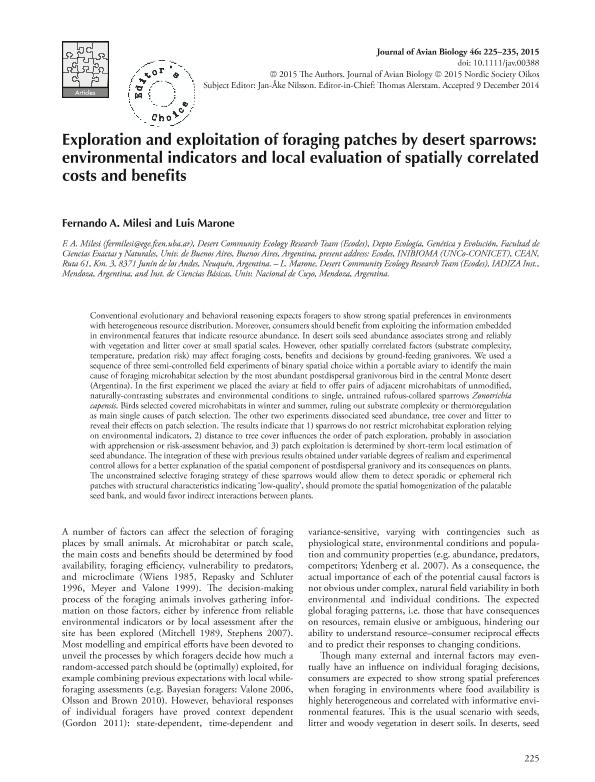Artículo
Exploration and exploitation of foraging patches by desert sparrows: environmental indicators and local evaluation of spatially correlated costs and benefits
Fecha de publicación:
05/2015
Editorial:
Wiley
Revista:
Journal Of Avian Biology
e-ISSN:
1600-048X
Idioma:
Inglés
Tipo de recurso:
Artículo publicado
Clasificación temática:
Resumen
Conventional evolutionary and behavioral reasoning expects foragers to show strong spatial preferences in environments with heterogeneous resource distribution. Moreover, consumers should benefit from exploiting the information embedded in environmental features that indicate resource abundance. In desert soils seed abundance associates strong and reliably with vegetation and litter cover at small spatial scales. However, other spatially correlated factors (substrate complexity, temperature, predation risk) may affect foraging costs, benefits and decisions by ground-feeding granivores. We used a sequence of three semi-controlled field experiments of binary spatial choice within a portable aviary to identify the main cause of foraging microhabitat selection by the most abundant postdispersal granivorous bird in the central Monte desert (Argentina). In the first experiment we placed the aviary at field to offer pairs of adjacent microhabitats of unmodified, naturally-contrasting substrates and environmental conditions to single, untrained rufous-collared sparrows Zonotrichia capensis. Birds selected covered microhabitats in winter and summer, ruling out substrate complexity or thermoregulation as main single causes of patch selection. The other two experiments dissociated seed abundance, tree cover and litter to reveal their effects on patch selection. The results indicate that 1) sparrows do not restrict microhabitat exploration relying on environmental indicators, 2) distance to tree cover influences the order of patch exploration, probably in association with apprehension or risk-assessment behavior, and 3) patch exploitation is determined by short-term local estimation of seed abundance. The integration of these with previous results obtained under variable degrees of realism and experimental control allows for a better explanation of the spatial component of postdispersal granivory and its consequences on plants. The unconstrained selective foraging strategy of these sparrows would allow them to detect sporadic or ephemeral rich patches with structural characteristics indicating ‘low-quality’, should promote the spatial homogenization of the palatable seed bank, and would favor indirect interactions between plants.
Palabras clave:
Seed Predation
,
Heterogeneity
,
Rufous-Collared Sparrow
Archivos asociados
Licencia
Identificadores
Colecciones
Articulos(INIBIOMA)
Articulos de INST. DE INVEST.EN BIODIVERSIDAD Y MEDIOAMBIENTE
Articulos de INST. DE INVEST.EN BIODIVERSIDAD Y MEDIOAMBIENTE
Citación
Milesi, Fernando Adrian; Marone, Luis; Exploration and exploitation of foraging patches by desert sparrows: environmental indicators and local evaluation of spatially correlated costs and benefits; Wiley; Journal Of Avian Biology; 46; 3; 5-2015; 225-235
Compartir




